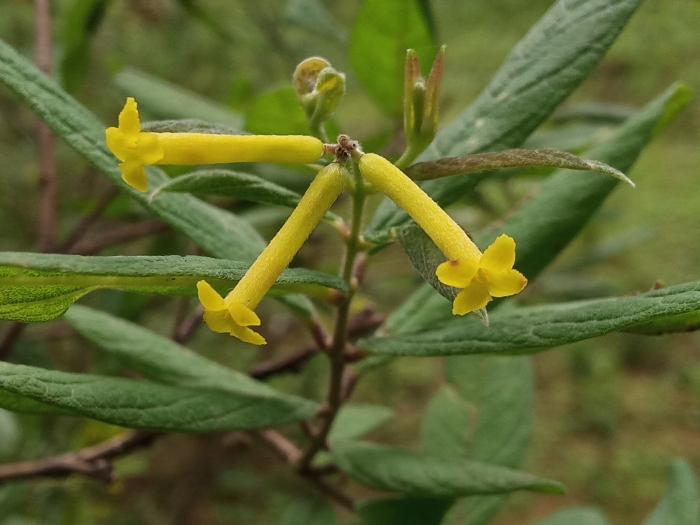Grey Leaved Wikstroemia
(Wikstroemia canescens)
Grey Leaved Wikstroemia (Wikstroemia canescens)
/
/

Dutta Roy Sagnik
CC BY 4.0
Image By:
Dutta Roy Sagnik
Recorded By:
Copyright:
CC BY 4.0
Copyright Notice:
Photo by: Dutta Roy Sagnik | License Type: CC BY 4.0 | License URL: http://creativecommons.org/licenses/by/4.0/ | Rights Holder: Dutta Roy Sagnik | Publisher: iNaturalist | Date Created: 2022-06-23T14:02:29-07:00 |


















Estimated Native Range
Summary
Wikstroemia canescens, commonly known as Grey Leaved Wikstroemia, is a deciduous shrub native to the understory of temperate forests, hillsides, and mountainous regions in Asia. It typically grows to a height of 1-4 feet (0.3-1.2 meters) and a width of 1-2 feet (0.3-0.6 meters). This shrub has a compact, rounded form with slender, arching branches. The leaves are a distinctive grey-green color, lending the plant its common name. The small, tubular yellow flowers bloom in summer and are not particularly showy, but they do attract pollinators such as bees and butterflies.
Grey Leaved Wikstroemia is valued for its drought tolerance and its ability to thrive in a variety of soil types, including clay, loam, and sandy soils. It is often used in rock gardens, as a low hedge, or in mixed shrub borders for its unique foliage color and texture. It requires medium amounts of water and can be grown in full sun to part shade, making it versatile for different garden settings. While it is not known for significant pest or disease problems, it can occasionally suffer from root rot if planted in poorly drained soils.CC BY-SA 4.0
Grey Leaved Wikstroemia is valued for its drought tolerance and its ability to thrive in a variety of soil types, including clay, loam, and sandy soils. It is often used in rock gardens, as a low hedge, or in mixed shrub borders for its unique foliage color and texture. It requires medium amounts of water and can be grown in full sun to part shade, making it versatile for different garden settings. While it is not known for significant pest or disease problems, it can occasionally suffer from root rot if planted in poorly drained soils.CC BY-SA 4.0
Plant Description
- Plant Type: Shrub
- Height: 1-4 feet
- Width: 1-2 feet
- Growth Rate: Moderate
- Flower Color: Yellow
- Flowering Season: Summer
- Leaf Retention: Evergreen
Growth Requirements
- Sun: Full Sun, Part Shade
- Water: Medium
- Drainage: Medium, Fast
Common Uses
Border Plant, Low Maintenance, Potted Plant
Natural Habitat
native to the understory of temperate forests, hillsides, and mountainous regions in Asia
Other Names
Common Names:
Scientific Names: , Wikstroemia canescens, Daphne canescens, Daphne inamoena, Daphne oppositifolia, Daphne oppositifolia, Daphne sericea, Daphne virgata, Diplomorpha canescens, Diplomorpha virgata
GBIF Accepted Name: